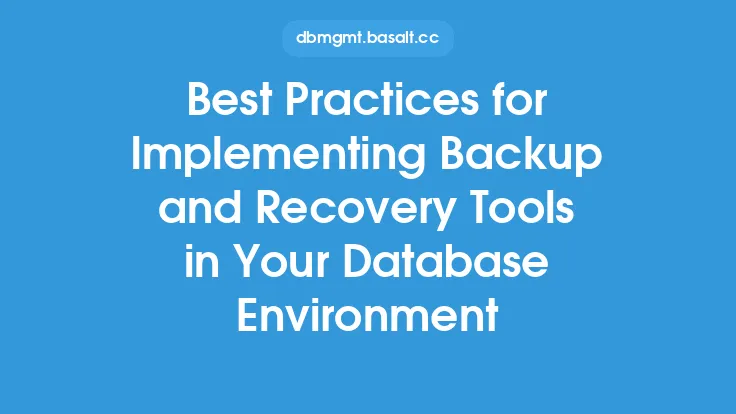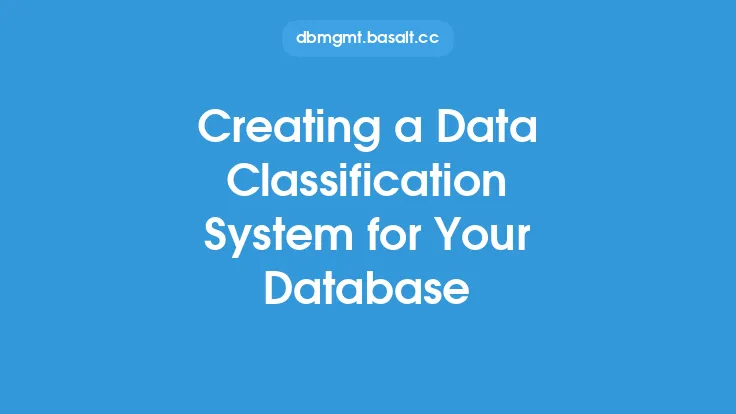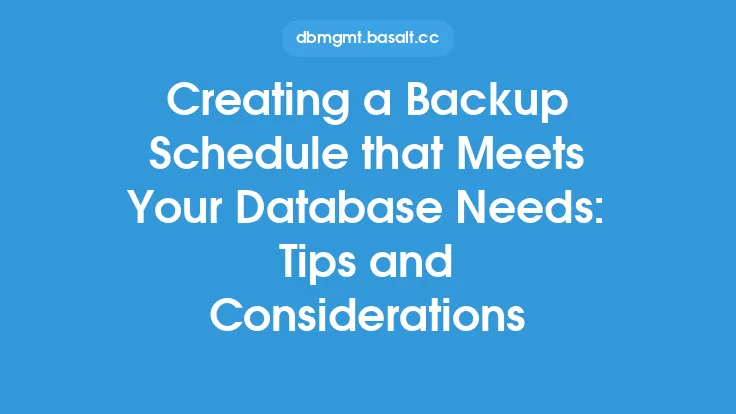Implementing a reliable backup automation process for your database is crucial to ensure the integrity and availability of your data. A well-designed backup automation process can help prevent data loss, reduce downtime, and improve overall database performance. In this article, we will discuss the key components and best practices for implementing a reliable backup automation process for your database.
Key Components of a Backup Automation Process
A reliable backup automation process consists of several key components, including backup scheduling, data selection, backup storage, and verification. Backup scheduling refers to the process of defining when and how often backups are taken. Data selection involves identifying the specific data to be backed up, such as entire databases, individual tables, or specific data ranges. Backup storage refers to the location and medium used to store the backed-up data, such as disk, tape, or cloud storage. Verification involves checking the integrity and completeness of the backed-up data to ensure it can be restored in case of a failure.
Choosing the Right Backup Automation Tool
Choosing the right backup automation tool is critical to implementing a reliable backup automation process. There are several factors to consider when selecting a backup automation tool, including compatibility with your database management system, ease of use, scalability, and cost. Some popular backup automation tools include database-specific tools, such as Oracle RMAN and Microsoft SQL Server Backup, as well as third-party tools, such as Veritas NetBackup and Commvault. When selecting a backup automation tool, consider the following factors: ease of use, scalability, compatibility, and cost.
Configuring Backup Schedules
Configuring backup schedules is a critical step in implementing a reliable backup automation process. The frequency and timing of backups depend on several factors, including the size and complexity of the database, the rate of data change, and the recovery point objective (RPO) and recovery time objective (RTO). The RPO refers to the maximum amount of data that can be lost in case of a failure, while the RTO refers to the maximum amount of time it takes to restore the database to a functional state. When configuring backup schedules, consider the following best practices: schedule backups during periods of low activity, use incremental backups to reduce storage requirements, and test backups regularly to ensure data integrity.
Implementing Data Retention and Rotation Policies
Implementing data retention and rotation policies is essential to managing backup storage and ensuring that backups are available for restore. A data retention policy defines how long backups are kept, while a rotation policy defines how often backups are rotated. A common rotation policy is the grandfather-father-son (GFS) rotation, which involves taking daily, weekly, and monthly backups. When implementing data retention and rotation policies, consider the following best practices: define a clear retention policy, use a rotation policy to manage storage, and monitor backup storage to ensure it is adequate.
Monitoring and Testing Backup Automation
Monitoring and testing backup automation is critical to ensuring that backups are successful and can be restored in case of a failure. Monitoring involves tracking backup jobs, storage usage, and data integrity, while testing involves restoring backups to a test environment to ensure data integrity and completeness. When monitoring and testing backup automation, consider the following best practices: monitor backup jobs and storage usage, test backups regularly, and use automated testing tools to simplify the testing process.
Best Practices for Backup Automation
Implementing a reliable backup automation process requires following best practices, including defining clear backup policies, using automation tools, and monitoring and testing backups. Additional best practices include using encryption to protect backed-up data, using secure authentication and authorization to control access to backups, and documenting backup procedures to ensure knowledge transfer. By following these best practices, you can ensure that your backup automation process is reliable, efficient, and effective.
Common Challenges and Solutions
Implementing a reliable backup automation process can be challenging, and common challenges include managing backup storage, ensuring data integrity, and restoring backups in case of a failure. To overcome these challenges, consider the following solutions: use data deduplication and compression to reduce storage requirements, use checksums and hash values to ensure data integrity, and use automated restore tools to simplify the restore process. Additionally, consider using cloud storage to provide offsite storage and disaster recovery capabilities.
Conclusion
Implementing a reliable backup automation process is critical to ensuring the integrity and availability of your database. By understanding the key components of a backup automation process, choosing the right backup automation tool, configuring backup schedules, implementing data retention and rotation policies, monitoring and testing backup automation, and following best practices, you can ensure that your backup automation process is reliable, efficient, and effective. Remember to stay vigilant and continually monitor and test your backup automation process to ensure it remains effective and reliable over time.





